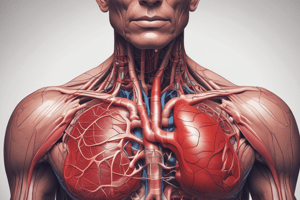Podcast
Questions and Answers
The circulatory system is a network of tubes and vessels through which ______ flows throughout the body to deliver oxygen to cells and remove waste products.
The circulatory system is a network of tubes and vessels through which ______ flows throughout the body to deliver oxygen to cells and remove waste products.
blood
There are four main components of the circulatory system: the heart, blood vessels, blood, and ______.
There are four main components of the circulatory system: the heart, blood vessels, blood, and ______.
blood circulation
Blood circulation involves the movement of blood through the circulatory system to transport nutrients, oxygen, hormones, and ______ products.
Blood circulation involves the movement of blood through the circulatory system to transport nutrients, oxygen, hormones, and ______ products.
waste
Blood circulation consists of three primary systems: the pulmonary circulation, systemic circulation, and ______ circulation.
Blood circulation consists of three primary systems: the pulmonary circulation, systemic circulation, and ______ circulation.
The pulmonary circulation carries deoxygenated blood from the body's venous system to the lungs to obtain ______.
The pulmonary circulation carries deoxygenated blood from the body's venous system to the lungs to obtain ______.
The systemic circulation distributes the ______ blood throughout the body via the aorta, the largest artery.
The systemic circulation distributes the ______ blood throughout the body via the aorta, the largest artery.
The portal circulation collects nutrient-rich blood from the digestive tract and delivers it to the ______, where it receives further processing.
The portal circulation collects nutrient-rich blood from the digestive tract and delivers it to the ______, where it receives further processing.
The ABO system is responsible for determining blood types based on antibodies and ______ present on red blood cells.
The ABO system is responsible for determining blood types based on antibodies and ______ present on red blood cells.
The ABO system includes four main blood groups: A, B, AB, and ______.
The ABO system includes four main blood groups: A, B, AB, and ______.
Blood types in the ABO system are determined by the presence of specific ______ on red blood cells.
Blood types in the ABO system are determined by the presence of specific ______ on red blood cells.
Flashcards are hidden until you start studying
Study Notes
Circulatory System
The circulatory system is a network of tubes and vessels through which blood flows throughout the body to deliver oxygen to cells and remove waste products. There are four main components of the system: the heart, blood vessels, blood, and blood circulation. Let's dive deeper into each subtopic: blood circulation and the ABO system.
Blood Circulation
Blood circulation involves the movement of blood through the circulatory system to transport nutrients, oxygen, hormones, and waste products. It consists of three primary systems: the pulmonary circulation, systemic circulation, and portal circulation. The pulmonary circulation carries deoxygenated blood from the body's venous system to the lungs to obtain oxygen, enabling the exchange of carbon dioxide for oxygen. After receiving oxygen, the blood travels through the systemic circulation, which distributes the oxygenated blood throughout the body via the aorta, the largest artery. Lastly, the portal circulation collects nutrient-rich blood from the digestive tract and delivers it to the liver, where it receives further processing.
ABO System
The ABO system is responsible for determining blood types based on antibodies and antigens present on red blood cells. The system includes four main blood groups: A, B, AB, and O. Each group has unique combinations of proteins on the surface of red blood cells that interact with matching or mismatching factors within recipient blood samples during transfusions. The ABO system plays a crucial role in ensuring successful blood transfusions, as a match between donor and recipient ensures minimal risk of rejection and adverse reactions.
Studying That Suits You
Use AI to generate personalized quizzes and flashcards to suit your learning preferences.




